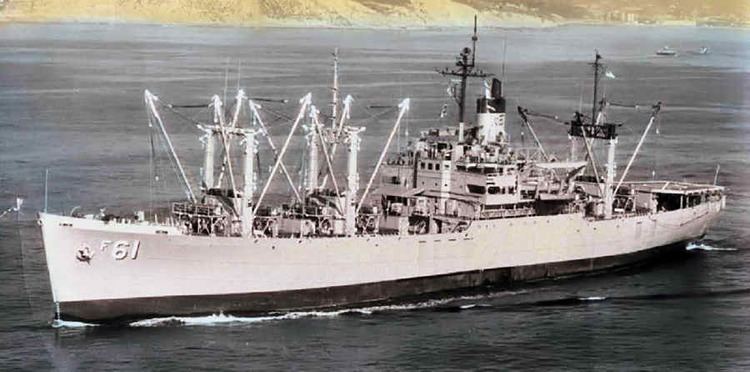Laid down 15 April 1942 Commissioned 13 October 1961 Struck 1 June 1976 Launched 1 July 1942 Displacement 12.86 million kg | Acquired 8 August 1961 Decommissioned circa 1969 Construction started 15 April 1942 Length 140 m Draft 8.1 m | |
 | ||
Ordered as SS Flying Scud,C2-S-B1 hull, MC hull 188 | ||
USS Procyon (AF-61) was an Alstede-class stores ship acquired by the U.S. Navy. Her task was to carry stores, refrigerated items, and equipment to ships in the fleet, and to remote stations and staging areas.
Contents
A pre-commissioning history
Procyon was laid down 15 April 1942 as MC hull No. 188 by the Moore DD Co., Oakland, California; launched 1 July 1942 as SS Flying Scud; sponsored by Mrs. Carl W. Flesher; operated by the United Fruit Co. (18 August 1943 - 4 September 1946) under a General Agency Agreement with the Maritime Commission; acquired by the Pacific Far East Lines, Inc., under bare boat charter (5 September 1946 - 19 October 1948); transferred to the General Steamship Corp. 19 October 1948 under a General Agency Agreement; returned to MARAD 26 October 1948 and laid tip at Suisun Bay, California; re-chartered by Pacific Far East Lines 10 December 1948; placed in the Maritime Reserve Fleet at Suisun Bay 24 February 1956; acquired by the Navy 8 August 1961 and converted to Navy use at the San Francisco Naval Shipyard; renamed Procyon (AF–61), 13 October 1961; and commissioned 24 November 1961, Capt. N.I. Lee, Jr., in command.
Assigned to WestPac
After shakedown, Procyon engaged in the testing of Fast at Sea Transfer equipment (FAST) with other replenishment ships of the U.S. Pacific Fleet, before deploying to the Western Pacific Ocean 2 June 1962. She remained in and around Sasebo, Japan for three months, returning to the U.S. 26 September. She made her second WestPac deployment in support of U.S. 7th Fleet carrier task groups 23 February 1963, returning 7 July to conduct Fleet exercises and night replenishment operations until 6 October. Procyon was ordered back to WestPac in late October, returning 7 March 1964 for coastal operations. She was employed in the Gulf of Tonkin with the 7th Fleet (1 August–7 December) during the Vietnam crises.
Vietnam operations
Procyon operated in support of the 7th Fleet off the coast of Vietnam, returning periodically to the U.S. for upkeep and training. She provided logistic support to Task Force 77 units on Yankee Station, as well as to Operation Market Time patrol craft along the coast and in harbor facilities from Da Nang to Vung Tau. The ship remained with the U.S. Pacific Fleet until 1970.
Decommissioning
Procyon was decommissioned circa 1969/1970 and struck from the Naval Register, 1 June 1976. She was returned to MARAD in 1981 for lay up in the National Defense Reserve Fleet. MARAD eventually sold "Procyon." The ship's ultimate fate is unknown. The Ultimate fate of Procyon is now known. Here it is as taken from the Procyon History Site offered by Google.com: Procyon (AF–61) was laid down 15 April 1942 as MC hull No. 188 by the Moore DD Co., Oakland, Calif.; launched I July 1942 as SS Flying Scud; sponsored by Mrs. Carl W. Flesher; operated by the United Fruit Co. (18 August 1943 – 4 September 1946) under a General Agency Agreement with the Maritime Commission; acquired by the Pacific Far East Lines, Inc., under bare boat charter (5 September 1946 – 19 October 1948); transferred to the General Steamship Corp. 19 October 1948 under a General Agency Agreement; returned to MARAD 26 October 1948 and laid tip at Suisun Bay, Calif.; re-chartered by Pacific Far East Lines 10 December 1948; placed in the Maritime Reserve Fleet at Suisun Bay 24 February 1956; acquired by the Navy 8 August 1961 and converted to Navy use at the San Francisco Naval Shipyard; renamed Procyon (AF–61), 13 October 1961; and commissioned 24 November 1961, Capt. N.I. Lee, Jr., in command.
After shakedown, Procyon engaged in the testing of Fast at Sea Transfer equipment (FAST) with other replenishment ships of the Pacific Fleet, before deploying to the Western Pacific 2 June 1962. She remained in and around Sasebo, Japan for three months, returning to the U.S. 26 September. She made her second WestPac deployment in support of 7th Fleet carrier task groups 23 February 1963, returning 7 July to conduct Fleet exercises and night replenishment operations until 6 October. Procyon was ordered back to WestPac in late October, returning 7 March 1964 for coastal operations. She was employed in the Gulf of Tonkin with the 7th Fleet (1 August–7 December) during the Vietnam crises.
Procyon has since operated in support of the 7th Fleet, in the struggle against communist aggression in Southeast Asia, off the coast of Vietnam, returning periodically to the U.S. for rest, upkeep and training. She provides logistic support to Task Force 77 units on Yankee Station, as well as to Market Time Patrol craft along the coast and harbor facilities from Da Nang to Vung Tau. Into 1970, Procyon continues a vital service to the U.S. Pacific Fleet.
Military awards and honors
Procyon earned ten campaign stars for Vietnam War service:
Procyon’s crew was eligible for the following medals:
